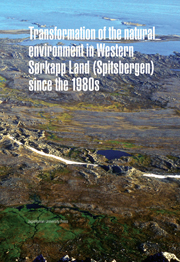Book contents
Vegetation
from Components of natural environment
Published online by Cambridge University Press: 05 September 2014
Summary
The flora of Svalbard is dominated by cryptogams, mainly lichenized fungi (lichens), 600 species, and bryophytes, 370 species (Elvebakk, Hertel 1996), and also cyanoprokaryota and algae (Matuła et al. 2007). Vascular plants are in the minority with about 170 species (Jónsdóttir 2005). Similar proportions can be observed in western Sørkapp Land, where lichen biota consist of 170 species (Olech 1990), while vascular plant flora includes 82 species (Dubiel 1990). This is typical for the High Arctic. Western Sørkapp Land is diverse in terms of habitat conditions such as terrain relief, geological subsoil, hydrological conditions, edaphic relationships, microclimate, etc. The vegetation in the region is dominated by lichens and bryophytes, and some flowering plants. Different vegetation types often create a complex mosaic.
The key factors determining the location of different types of vegetation in Arctic areas are terrain relief and hydrological conditions (Dubiel, Olech 1990; Elvebakk 1997).
Bedrock has an obvious influence on vegetation. The presence of Carboniferous sandstone correlates with the location of epilithic lichen communities and moss communities with Racomitrium lanuginosum, lichen tundra with Flavocetraria nivalis and Cladonia rangiferina. Triassic formations, in turn, overlap with vegetation dominated by vascular plants, e.g. Saxifraga nivalis, Bistorta vivipara (syn. Polygonum viviparum) and Papaver dahlianum. Other communities such as the Gymnomitrion corraloides community, the Cetrariella delisei community and the Bistorta vivipara community, are found on coastal ridges and small hills.
- Type
- Chapter
- Information
- Transformation of the Natural Environment in Western Sorkapp Land (Spitsbergen) since the 1980s , pp. 43 - 46Publisher: Jagiellonian University PressPrint publication year: 2011

